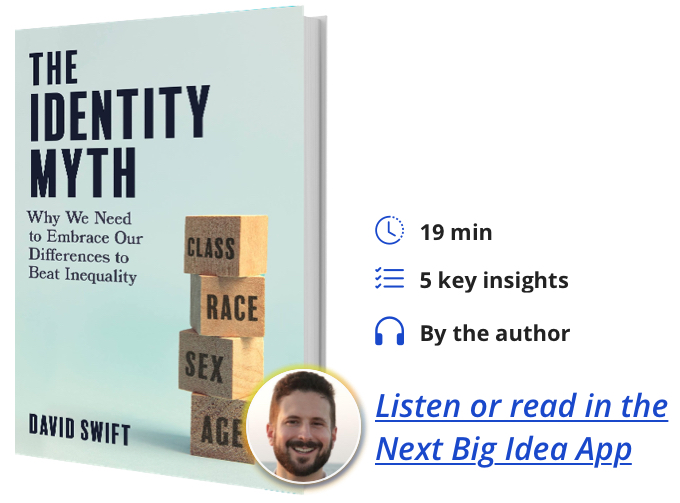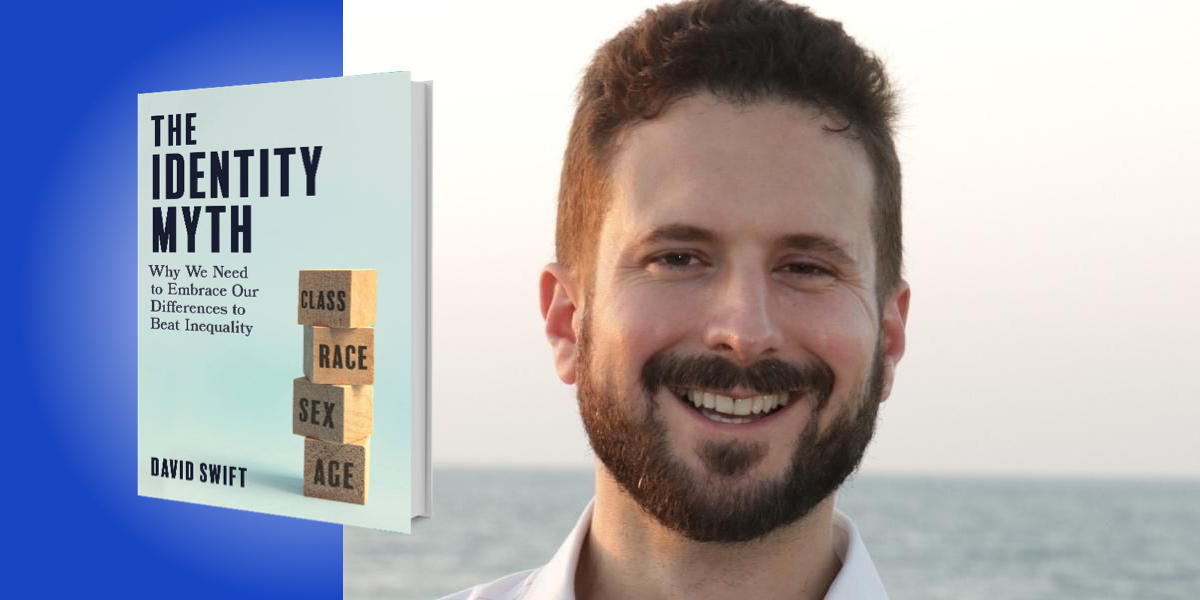David Swift is a historian who primarily researches identity issues in the 20th century, such as class, ethnicity, and gender.
Below, David shares 5 key insights from his new book, The Identity Myth: Why We Need to Embrace Our Differences to Beat Inequality. Listen to the audio version—read by David himself—in the Next Big Idea App.

1. Class has become post-modern.
In the 1850s, Karl Marx theorized that one’s class was composed of a base—the sort of thing you did for a living, how much money you had, your income—and a superstructure, which was cultural and political.
This idea is not fashionable anymore, not least because of the persistence of people with working class jobs who vote for the political right. We have seen conservative politicians, such as Boris Johnson in the UK and Donald Trump in the U.S., make inroads with what were once considered working class voters.
At the same time, it has been contested who is or isn’t working class. For example, politicians such as Trump and Missouri Senator Josh Hawley, or Johnson and Nigel Farage in the UK, say that they represent the real working class—meaning not just somebody who has a particular kind of job, but someone who has a particular kind of attitude. Whereas politicians on the left, such as Bernie Sanders, AOC, or Jeremy Corbyn, say that “working class” is a broader designation than how Trump or Johnson suggest. In fact, voices on the Left would say that the Democrats and British Labour are doing just as well among the working class as they ever have—it’s just that what should be considered working class has shifted.
So, we have people on the Right who would say that the working class is a particular kind of person with conservative beliefs, whereas those on the Left would say we need to redefine what working class means in the first place. In both cases, we see the detachment of class from its original materialist underpinnings. This is what I mean when I say that class has become postmodern.
2. The future of conservatism is Brown.
Zapata County, Texas, is the second-most-Hispanic county in the United States. In 2012, Obama won it by 43 points. In 2016, Clinton won it by 33 points. Yet in 2020, Biden lost it by 5 percentage points. This was part of a broader trend: Donald Trump’s 2020 vote share went up among every ethnic group—apart from white people!
“Even among Black Americans, there is evidence that their support for the Democrats stems more from an association of the GOP with racism, rather than any great love for liberal politics.”
While Democrats still dominate amongst Black American voters (with almost 90 percent going for Biden in 2020), among Hispanics the Democrat vote share is around two-thirds, and falling rapidly. According to one poll, support for the Democrats from Hispanic working class voters declined by 18 points between 2016 and 2020.
Even among Black Americans, there is evidence that their support for the Democrats stems more from an association of the GOP with racism, rather than any great love for liberal politics. The sociologist Tasha Philpot argues that African-Americans are politically conservative, just not Republican, and this conservatism displays itself in unexpected ways. According to a Siena poll, 91 percent of Black respondents want more cops on the New York subway, which is closer to the figure for Republican respondents (97 percent) than Democrats (82 percent). This suggests that the political centre of gravity for Black Americans is more conservative than for white democrats. We can see this in the election of former police officer and Black American, Eric Adams, as mayor of New York.
This trend is happening in the UK. While the Labour party still performs better among most ethnic minority groups, the conservative share of the minority vote has been climbing for years. For instance, with the Brexit referendum in 2016, it is estimated that around one-third of BAME Britons voted Leave. Or, in the current leadership election for the conservative party, about half of the candidates are Black or Asian.
When we consider the political climate in countries such as Brazil, India, and the Philippines, we see the potential for rising Black and Brown conservatism to have increasing influence.
3. The culture of humanity belongs to all humans.
In cultural studies there is something called the “pizza effect.” This refers to Neopolitan immigrants taking their simple dish of baked dough and a tomato sauce to America, where they added new toppings, reimported this back to Italy, only for this dish to later be discovered by Americans as “authentic” Italian pizza.
“This intermingling over centuries makes it very difficult to say a certain aspect of culture belongs to anyone.”
M.K. Gandhi first read the Bhagavad Gita—one of the most important Hindu texts—in English, while he was in London. James Brown and his band traveled to Nigeria in the 1960s and were amazed by how familiar they found the music of Fela Kuti and other Afrobeat singers. This was the result of former slaves and migrants returning to West Africa from the United States. This intermingling over centuries makes it very difficult to say a certain aspect of culture belongs to anyone.
When James Baldwin writes in Notes of a Native Son of the Alpine yokels, staring slack-jawed at the first Black man they have seen, “these people cannot be, from the point of view of power, strangers anywhere in the world; they have made the modern world, in effect, even if they do not know it.” But this is a Eurocentric view because many key aspects of modernity, from astronomy to mathematics to gunpower to paper, have decidedly non-European origins. It’s very much the same with culture.
4. Not all gays are queer; not all queer people are gay.
With the advance of LGBT rights, we’ve seen an argument that LGBT people have an obligation to be queer, which refers not to their sexuality but to a political-cultural identity. The problem is that many LGBT people want heteronormative lifestyles—many are conservative, and some even far-Right.
In Israel, Amir Ohana is a rising star of the Likud party and their first openly gay member to serve in the Knesset (parliament). As of February 2021, he was trying to prevent prisoners from receiving COVID-19 vaccines. In Germany, the leader of the AfD, Alice Weidel, is a lesbian. Siv Jensen, leader of the Norwegian anti-immigrant Progress Party, complains about the sneaking Islamisation of Norwegian society but yet was honored with a “gay best friend” prize at a Norwegian LGBT award ceremony. Florian Philippot, until 2017 the most senior male politician in the far-Right French Rassemblement national, is gay, and it appears that the RN has reasonable levels of support among French gays. A survey of 3,200 gay French men by the dating app Hornet found that one in five were planning to vote for its leader, Marine Le Pen, in the 2017 presidential election.
This complicates talk of a community of LGBT people. The sociologist Eleanor Formby counsels against using the phrase “LGBT community” as it “implies that LGBT people automatically belong to a ready-made community” and this “is simply not the case.” Formby says it is similar to talking of a brown-eyed community or a blonde community.
“Sociologist Eleanor Formby counsels against using the phrase ‘LGBT community’ as it ‘implies that LGBT people automatically belong to a ready-made community’ and this ‘is simply not the case.’”
Media, political, and academic attention should be on practical commonalities: HIV/AIDs funding, marriage equality and legal rights, and the threat of violence and death. Instead of talking about who fits with some queer idea which is policed by self-declared authorities, it’s better to focus on material concerns.
5. The kids are alright.
The author Anne Helen Petersen published a hit book, Can’t Even, talking about the difficulties for young people today, from buying a home to finding steady work. On the Right you often hear criticisms about young people as frivolous snowflakes who squander their income, while from the Left young people are depicted as committed radicals who are going to save the world from capitalism and climate change. In reality, both stereotypes are wildly inaccurate.
Contrary to the impression given in Petersen’s book, only 39 percent of U.S. millennials have a college degree, whereas fewer than 40 percent of 18-year-olds in the UK attend university. Yet we often talk about young people as though they are all college graduates with left-wing or liberal political beliefs. But there are huge numbers of kids in Britain and America who do not go to university, who stay in their home towns after high school, and go straight into the workforce rather than spend years accumulating expensive and underused degrees.
The politics of young people are complicated: in the UK, 18- to 21-year-olds are more right wing than 21- to 30-year-olds. In India, the youth membership of the Democratic and Labour parties (the BJP), has a range of views that are very conservative. In the U.S., Democrats under 50 were more than twice as likely to say feminism has done more harm than good compared to older co-partisans. They were also much more likely to agree that men are now under-valued in society, and that gender ideology has been corrosive. In Europe, young people are far more likely to support far-Right politicians, such as Marine Le Pen, than are older people.
Young people, their politics and culture, are infinitely more complicated than we might expect.
To listen to the audio version read by author David Swift, download the Next Big Idea App today:































